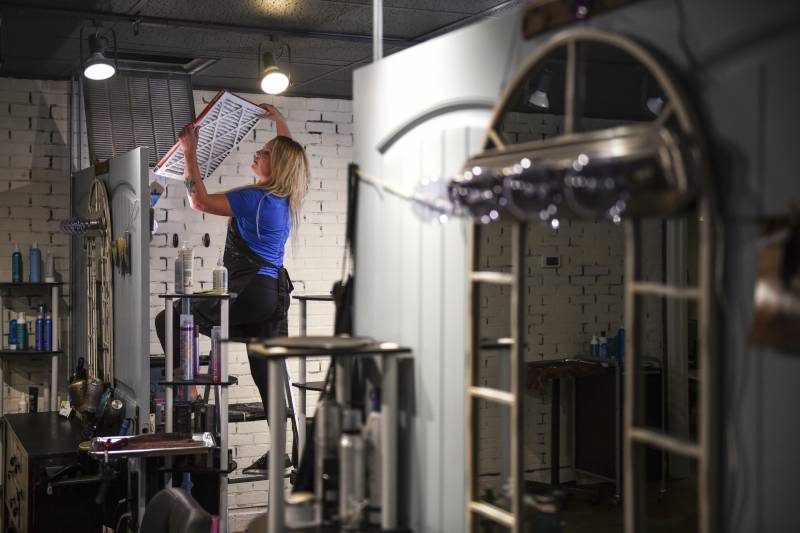“Avoid generating other pollutants indoors: temporarily avoid cooking on a gas stove, candles, incense, etc.,” she says. “Shut off kitchen and bathroom exhaust fans to reduce air exchange with outdoors.”
My school has a good filter, but we bring in outdoor air to make it safer for students, in the pandemic. We can’t do that when there is wildfire smoke. What then?
Smoke particles range in size hugely, and they can be ultra fine, smaller than the particles that carry the coronavirus. That means buildings with a MERV 13 filter will do a good job of capturing particles that carry the virus, but will only capture some wildfire smoke, says Richard Corsi, dean of engineering and computer science at Portland State University. Some buildings have systems that can accommodate a stronger filter, like a MERV 14, 15, 16 or even a HEPA filter, but this is not the case for all buildings. A stronger filter would be more effective at cleaning the air of both hazards.
If buildings can’t accommodate stronger filters and therefore cannot increase ventilation due to wildfire smoke, Corsi advises significantly bringing down the number of people using the building, or closing the building for the time being.
Pistochini agrees. “We are stuck in an impossible situation,” she says. “The pandemic dictates we go outside, the wildfire dictates we go inside.”
“The only widely available technology I’m aware of that tackles both these things at once is filters,” she said. Considering we’re in a pandemic, Pistochini still recommends building operators draw in some air from the outside, especially if a building has at least a MERV13 filter.
Then, both Pistochini and Corsi agree, portable air filters will help with smoke and the virus.
Turning to the Coronavirus Pandemic
As we return to schools and offices, what practices should we be asking our schools and employers to adopt in these shared indoor environments?
- Wear masks — even with physical distancing, says Corsi. To make this an easier pill to swallow, Corsi says give people breaks during the day during which they can go outside, physically distance, and take off their mask: a “mask break.” That is, assuming the air outside isn’t smoke-filled.
- Distance. “We’ve done the design of every classroom assuming that people are wearing an inner tube with a three foot radius, so that you’ll always be 6 feet away from anybody,” Corsi says, referring to the setup of spaces at Portland State University.
- Hold certain activities outside. Choir, playing wind instruments and group aerobic activities can cause more circulation of the virus because people are exhaling and inhaling at greater rates than they would be otherwise. Corsi suggests empty, above-ground parking structures.
- Schedule creatively. Corsi encourages people to stagger their schedules at the office to limit the number of people in an enclosed space. For schools, he says to operate at a lower capacity for each space, and leave ample time between classes to avoid congestion in hallways.
- Follow coronavirus etiquette. For shared spaces like elevators, Corsi says he practices “the new elevator etiquette”: mask on, just a few people in the elevator at a time, face away from one another, and no one talks.
How about the actual air we are breathing indoors?
When tackling potential coronavirus transmission indoors, atmospheric chemist at the Scripps Institution of Oceanography, Kim Prather, says, “I’m advising people to make sure that the room they’re in is well ventilated.”
That means opening windows and doors when possible. When that is not possible, consider what kind of HVAC system the buildings have.
Pistochini says we all think of an HVAC system as providing heating and cooling, but, she says, “It should do two other things: it should filter the air and it should provide ventilation.” Ventilation means bringing outdoor air inside and exhausting indoor air.
In terms of the coronavirus, filtration can pull particles out of the air that may contain the virus. Ventilation will dilute the concentration of particles in the indoor air.
Pistochini says it’s hard to visualize this with the actual virus. so she suggests imagining “your kid went and dropped a gallon full of glitter in your swimming pool.” To remove the glitter (i.e. the virus), “you could pump it through a filter. Or you could change the water. Those two things are basically what HVAC systems do for air,” she says.
But you need three things in place for the HVAC system to work, she says: a fan that is actually on and running, a decent filter changed regularly, and for the outdoor air intake to be open.
The air filters used in HVAC systems have ratings. For the coronavirus, scientists recommend a MERV 13 filter or greater.
Prather says one way people can tell whether there is enough ventilation in their indoor spaces is to actually measure the carbon dioxide in the air with a monitor. Prather says a well ventilated room will have a carbon dioxide level of 800 or less. A room that is not well ventilated will have higher levels of carbon dioxide, which builds as humans exhale. She says she would like to see these monitors, which cost roughly $100, installed in classrooms so teachers have an understanding of their indoor air quality.

